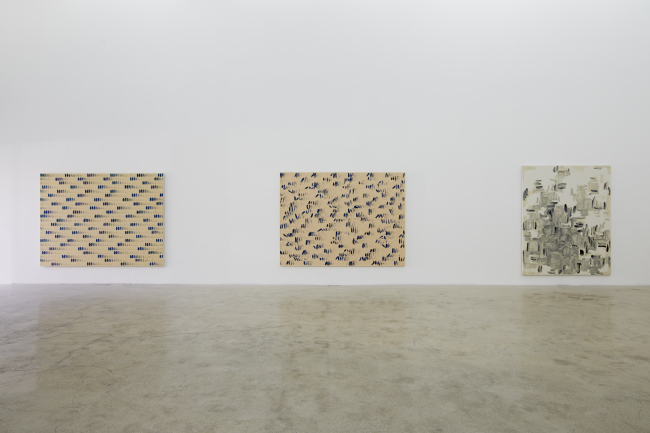‘Dansaekhwa’ under global spotlight
After emerging under ’60s, ’70s authoritarian rule, the monochrome style has evolved into distinctive art movement
By Lee Woo-youngPublished : Sept. 17, 2014 - 20:46
In the 1960s and 1970s, some Korean artists took on different painting methods. Instead of applying paint to canvas, they pushed thick paint from the back of the canvas, applied paint with a finger, or sprayed water onto the canvas surface.
Suppressed by the military-backed government, the artists sought to explore a deeper part of their mind through repetitive, performative painting. Criticized by their contemporary peers for turning away from reality, the artists continued to develop an abstract language in Korean art.
Artist Lee Ufan describes the act as done “in denial of reality,” and calls the time “frozen days” (without freedom of expression).
“There was an artist named Choi Byung-soo in Daegu, who scratched the surface of a newspaper sheet with a pencil until the pencil lines covered the whole surface. It was a typical expression of monochrome and self-denial of reality,” said Lee at the discussion on Dansaekhwa held at Kukje Gallery in Seoul earlier this month.
Forty years later, Korean monochrome painting, or Dansaekhwa, is under the global spotlight as a unique Asian abstract art movement. Exhibitions overseas and in Korea are underway, casting light on groups of Dansaekhwa masters of the 1960s to 1980s.
Suppressed by the military-backed government, the artists sought to explore a deeper part of their mind through repetitive, performative painting. Criticized by their contemporary peers for turning away from reality, the artists continued to develop an abstract language in Korean art.
Artist Lee Ufan describes the act as done “in denial of reality,” and calls the time “frozen days” (without freedom of expression).
“There was an artist named Choi Byung-soo in Daegu, who scratched the surface of a newspaper sheet with a pencil until the pencil lines covered the whole surface. It was a typical expression of monochrome and self-denial of reality,” said Lee at the discussion on Dansaekhwa held at Kukje Gallery in Seoul earlier this month.
Forty years later, Korean monochrome painting, or Dansaekhwa, is under the global spotlight as a unique Asian abstract art movement. Exhibitions overseas and in Korea are underway, casting light on groups of Dansaekhwa masters of the 1960s to 1980s.

Kukje Gallery in Seoul brings together the works of key Dansaekhwa artists of the 1970s and 1980s in the exhibition “The Art of Dansaekhwa,” which runs through Oct. 19. Curated by Yoon Jin-seob, art curator and promoter of the term Dansaekhwa in the global art world, the exhibition showcases some 18 monochrome paintings, offering insight into the Korean Dansaekhwa movement and its distinctive style.
What appears on the surface is not all about the painting. Behind the simple image, there are layers of paint applied hundred and thousand times, pencil lines drawn repetitively, and erased pencil marks. Artists like Chung Chang-sup and Park Seo-bo highlight the sense of touch by applying Korean mulberry paper onto the canvas surface.
“What’s fascinating about this group of the artists is the true versatility in the language. It’s truly original and universal like music,” said Sam Bardaouil, part of the independent curator duo Art Reoriented, during the the discussion at Kukje Gallery.
Dansaekhwa painting was first promoted overseas in the Japanese art circle in the 1970s, which simultaneously saw the emergence of the Mono-ha art movement. Artist Park Seo-bo said his Dansaekhwa paintings debuted at an exhibition in Japan in 1973, then shown in Korea later.
Park said he became “a monk” in painting Dansaekhwa. In resistance to the military dictatorship, the artist took on repetitive pencil line drawings on an ivory-colored canvas for his 1976 “Ecriture” painting.
“I sought to seclude myself from everything and reach a complete state of mind through repetitive gestures as monks practice asceticism,” said Park during the guided press tour of the exhibition.
The collective, yet individual resistant expression has found its place in distinctive contemporary Asian abstract art. Artist Lee Ufan, an important figure in the Korean Dansaekhwa movement and theoretical leader of the Japanese Mono-ha art movement, had his works shown extensively at the Guggenheim Museum in 2011 and at Versailles until November this year.
“Korea is one of the very few Asian countries with a vigorous history of abstraction. The time is ripe for a reassessment of Dansaekhwa’s place in the broader history of art,” said Joan Kee, art history professor at the University of Michigan-Ann Arbor and author of “Contemporary Korean Art: Tansaekhwa and the Urgency of Method,” an in-depth overview of Korean monochrome painting emerged since the 1960s, in an email interview last year.
The LA-based art gallery Blum & Poe examines Korean Dansaekhwa paintings of the 1960s to 1980s, focusing on six of the most representative Dansaekhwa masters, including Lee Ufan, Ha Chong-hyun, Chung Sang-hwa, Kwon Young-woo, Park Seo-bo and Yun Hyong-keun.
Curated by Joan Kee, “From All Sides: Tansaekhwa on Abstraction” is one of the recent overseas exhibitions shedding light on the Korean Dansaekhwa movement.
K-Auction in Seoul presents works of Dansaekhwa masters in its fall auction scheduled for Sept. 25. Some of the highlight paintings include Lee Ufan’s 1982 “From Line No. 12-12,” which is estimated to be between $356,400 and $495,000. A rare Dansaekhwa painting in blue hue by Chung Sang-hwa is also on the block with the price ranging between $11,800 and $15,800.
By Lee Woo-young (wylee@heraldcorp.com)


















![[Today’s K-pop] Treasure to publish magazine for debut anniversary](http://res.heraldm.com/phpwas/restmb_idxmake.php?idx=642&simg=/content/image/2024/07/26/20240726050551_0.jpg&u=)